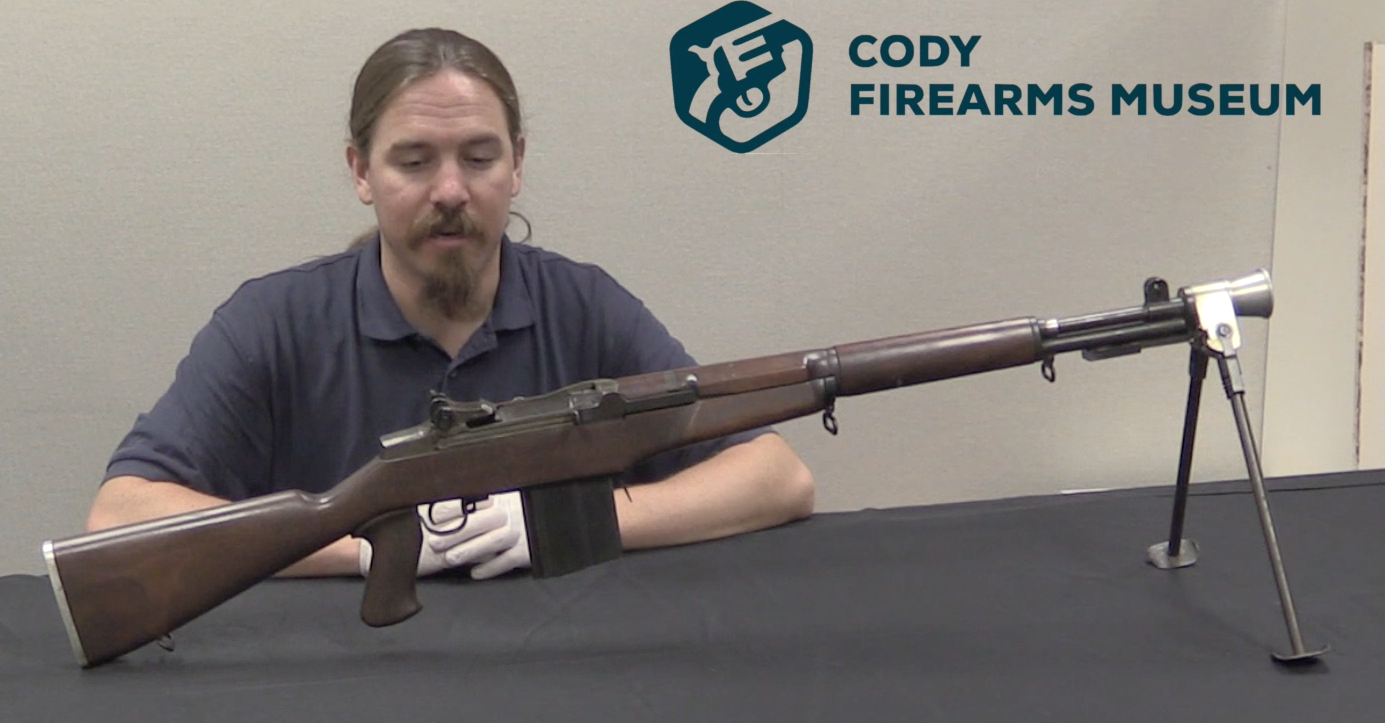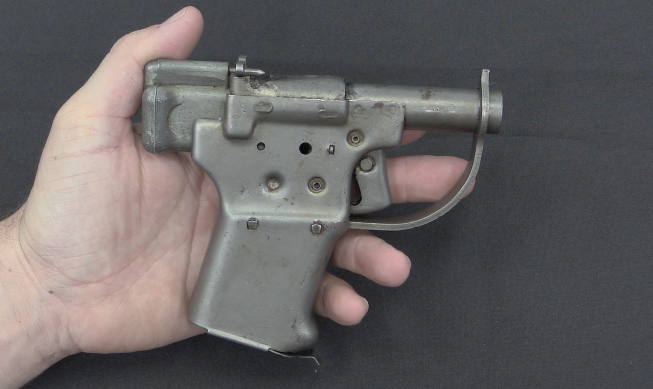With the impending success of Colt’s program to develop new .45 caliber pistol for the US military (the 1911), the company began to look for ways to exploit the work that had gone into it. They had previously sold lots of .38 caliber automatic pistols, so why not offer a .38 caliber version of the 1910? In addition to a potential US commercial market, a new rimless .38 caliber cartridge might be just teething to get some foreign military contracts. So about 5 pistols were handmade by Colt’s tool room around both the old .38 ACP cartridge and a very similar 9.8mm cartridge (which was tested in both semi-rimmed and rimless variations). These guns were not conversions of the .45 caliber frame, but rather wholly new guns built around the smaller ammunition. They are slightly smaller in scale across all dimensions compared to the now-familiar M1911.
At the same time, Colt’s relationship with FN was getting tense as FN was selling more guns into Central and South America. Colt decided to send their new 9.8mm prototype (in the hands of Eugene Reising, then a Colt employee) to pistol trials in England and Romania. While winning a contract would be great, just appearing would let FN know that Colt was still paying attention. In the end, Colt didn’t win any contracts – but they were able to negotiate a new marketing agreement with FN from a stronger position.
The experimental .38/9.8mm pistols gathered dust in storage, as they were never ultimately put into production. In 1929, someone remembered them when Colt was releasing the M1911A1 in .38 Super. Serial number 3 (this pistol) was given a nice new finish and put into Colt’s factory museum (from whence it later was sold into the collector market).




If ıt were made; In 9mm Para. and without grip safety and with round hammer… It would be more chance… IMHO…
You are right and you do not have to be humble about that. I believe there are some 9mm Para models of the M1911 type pistol.
“(…)there are some 9mm Para models of the M1911 type pistol.”
Do you mean Star B Super
https://modernfirearms.net/en/handguns/handguns-en/spain-semi-automatic-pistols/star-a-b-b-super-p-eng/
or something else?
Yes, but this is still full size, like .45ACP is it not? I was thinking something adjusted to 9mm Para, scaled down to 85% as mentioned somewhere.
You might be thinking of the Star BKS Starlight, a locked-breech 1911-type pistol that was barely larger than most .380 ACP pocket automatics. It was the smallest of the Star “B” series pistols;
http://star-firearms.com/firearms/guns/b/
In fact, the B series were all smaller than the 1911, making them some of the most “size-efficient” 9 x 19mm pistols ever.
cheers
eon
Several 9x19mm scaled down 1911 style autos on the US market – my wife packs her SIG 938 w/ a light. Quite slim compared to my Glock 23, I don’t care for the recoil of the SIG. She likes it.
“(…)9mm Para(…)”
This is obvious choice in 2021, but I doubt it would be so in 1910.
re: If ıt were made; In 9mm Para. and without grip safety and with round hammer… It would be…
… known as the Springfield Armory EMP-4, although that does still have the grip safety.
What is known, if anything, about the 9.8mm ctg?
“What is known, if anything, about the 9.8mm ctg?”
For dimensions and photos of specimen see https://naboje.org/node/5003
Bullet was FMJ and weightning 8,6 g.
Also see;
Goddard, William G. “Colt’s .41 A.C. Model of 1903”. Guns & Ammo magazine, vol. 33, no. 2, Feb. 1989, pp. 40, 104-105.
The 9.8mm cartridge, like the .41 Automatic Colt, was apparently based on the .41 Colt revolver cartridge.
cheers
eon
Please, please someone rediscover this “amazing insight” of 1910 technology – but in double-stack.
Good point, no one thought of “double stack” then.
I would lead your attention to Para-Ordnance pistols, originally from Scarborough Ontario, before acquired by Remington. They started with series production of 1911 style double-stack pistols in early 1990s. I believe the division ceized to exist. https://en.wikipedia.org/wiki/Para_USA
Denny,
Sorry if I was unclear, but I’m well familiar with both Para-Ordnance and the competing “2011” series of double-stack 1911s. I own a Rock Island “1911A2″ 9mm that takes Para magazines. All of the above are horribly disproportionate to the dimensions of the 9mm cartridge, being designed for .45ACP (I have large hands, and still find them uncomfortably wide). The 2011 is slightly slimmer due to its use of a molded grip rather than screwed-on panels, but it also uses expensive magazines with a poor reputation for reliability.
I wasn’t saying they should have had double-stack magazines in 1910. I was hoping / suggesting that today’s manufacturers should apply the same, specific design philosophy as the Colt 1910 (also used in the Springfield EMP as Technotriticale noted) of scaling the pistol to the 9mm cartridge – but in double-stack.
In a year that just saw the introduction of two more double-stack 9mms with 1″ wide grips, there is zero excuse whatsoever why someone who prefers a crisp 1911 trigger should have to settle for a 1.5” wide abortion of a grip. I’m eagerly looking forward to the Dan Wesson DWX (if they ever show up in stores). To me the simplest solution (since the 2011 uses a detachable plastic grip) would be for someone to build a grip for some common, reliable, commercially available double-stack steel 9mm mag. Pretty please!
Edited to add (I wish there was an “edit” button!): I apologize if I came across as mocking Colt for not using double-stack magazines in 1910. I was actually mocking most 2021 manufacturers of 1911s for failing to apply a simple, obvious design principle that Colt recognized 111 years ago.
Yeah, I recall P18-9, they were handful, but not impossible. I guess it comes to length of fingers more than anything. I had short lived stint with the company while still in original location.
http://modernfirearms.net/userfiles/images/handguns/canada/1287742431.jpg
The frame was investment cast. The Para company started as tool-maker for IC patterns/ molds.
Not impossible to shoot, certainly, though pretty much impossible to conceal. Conversely, my P365 – even with a 15rd mag – disappears under gym shorts if I’m careful.
The 1911A2 also has a much less natural reach to the mag release and slide stop, and the narrow grip safety / wide grip combination sometimes caused my hand to “bridge” in such a way as to not deactivate the safety.
The Savage competitor to the trials was produced with double stack mags in some calibres. Complete with a long llama Omni style single column bit at the top.
Double stack was still relatively new. Iirc the mauser patent for double stack double feed was about 1894 or 1896, so 14 to 16 years earlier.
Admittedly, firearms technology was developing rapidly at that time
Except in some places
For example, prototypes of the crap that became the Springfield model of 1903, still had a single stack mag as late as 1902.
“no one thought of “double stack” then.”
Please explain why Elbert H Searle magazine from US804984A
https://patents.google.com/patent/US804984
does not count as double stack xor then xor thought?
“…no one thought of “double stack” then…”(С)
Except for Mauser, Lee and all the others?
I think most manufacturers realized that removable double row magazines would add a lot to the manufacturing cost.
And this does not give any special tactical benefits.
Perhaps something like an agreement to limit the arms race.
And in the civilian market, a large-capacity magazine is even more unnecessary.
This pistol was stillborn.
Twice weaker than almost the same size 45, but twice as large as a slightly weaker 9mm.
Great plot.
And the pistol is interesting.
Externally, good looking pistol – workmanship in particular. Now, why this “puny” 9.8mm (actually 9.65mm) caliber was not adopted instead of humongous .45ACP which no one else did?
The US Army came out of the 1899-1902 Moro Insurrection wanting a larger calibre than .38. Cadaver tests showed the minimum effective calibre for ball ammo was .42, so the US Army reverted to .45. .45ACP was introduced with the Colt model 1905.
Some have claimed the tests were not valid, etc. But I think an issue is that there were cases where a Moro warrior would slip in and wreck havoc with a machete. What was needed were not rifles, but handy side arms that would always be available. So sidearms were not a badge of office to be carried much and probably never shot, but a last line of defense that had better stop a determined person fast. .38’s had poor reports of effectiveness from the field, so the Army went big.
In WWI McBride, in A Rifleman Went to War, had high praise for the 45’s stopping power during trench raids, and thought 9mm Lugers were mainly good for use as clubs. He he was a very early advocate for an intermediate rifle cartridge, so he was not simply of the bigger is better camp.
Right, I forgot about that. Plus there was previous long experience with .45 Colt revolvers.
The basic problem wasn’t caliber but velocity, or rather the lack of it. The .38 Colt had about the same MV as the .45 Colt revolver, but with a 148-grain bullet instead of a 255-grain one. The result was about 190 FPE instead of 405 for the .45.
If they’d just changed the powder in the .38 to get MV up to 1,000 F/s or so, they’d have gotten about the same ME as the older .45 and solved the problem. which was pretty much how the .38 Smith & Wesson Special cartridge and the follow-on .38-.44 High Speed were created two decades later. Which led more-or-less directly to the .357 Remington Magnum in 1935.
It’s worth noting that the present-day MILSPEC 230-grain FMJ for the .45 ACP in U.S. service has a MV of 900 F/S to yield 410 FPE; roughly the same as the old 255-grain .45 revolver load.
If course, the U.S. MILSPEC standard 9 x 19mm 124-grain FMJ leaves the muzzle at 1,300 F/S for 465 FPE, putting it at the lower end of the .357 Magnum energy range.
As in traffic accident investigation, the first rule of killing power in firearms is “Speed Kills”.
cheers
eon
Eon,
I like your line of thinking, but you’re actually setting the bar too low.
There is a tendency to cut .45AARP (as one witty TFB commenter called it) unwarranted slack for its low pressure because it’s “old”. A review I read, of a modern .45 Colt / .45ACP revolver, praised it for being able to handle “hot” Colt loads of 21kpsi. Many act as though guns back then just couldn’t handle any more, but I know you are more knowledgeable than that.
The thing is, that was weak even in 1911. 9mm came first, and Luger loads were just as hot as today’s commercial loads. With comparable pressures and a COAL to match the average service revolver cylinder, a .38 cartridge could have trounced either .38Spl or .45ACP. If you have any doubt of its feasibility, compare the thinnest part of any service revolver frame to the little locking nubbies on a 1911 barrel.
Minor detail, but Mexico did adopt the 45ACP.
Yes, correct.
“but Mexico did adopt the 45ACP.”
Also Argentina, see Ballester-Rigaud https://guns.fandom.com/wiki/Ballester-Molina and Norway, see 11.25 m/m AUT. PISTOL M/1914 https://tvd.im/small-arms/4501-kongsberg-m-1914-kongsberg-colt.html
I think something like this would sell today and I think CZ is a quality company that could make it happen.
This is where they should aim, make something old-new; in metal only. There are way too many plastic striker fired guns.
If you need “(…)something old-new; in metal only.(…)” from CZ then get CZ-97B https://modernfirearms.net/en/handguns/handguns-en/czech-republic-semi-automatic-pistols/cz-97-eng/
Didnt Star in Spain during the 1920/30’s scale down the 1911 to 38 super/9mm largo
Star and also i think llama.
Those pistols had other design changes from the 1911 as well.
..and 9mm Parabellum (Model B)
Browning makes an 85% scaled 1911 in .380; it’s a great size. I wish 1911 makers would apply the same to 9mm.
1910- when a couple of Americans could grab some pistols and a few cases of ammunition and go to England, France, Germany, Austria, and Roumania without asking special permission or breaking any laws.
Cocaine was legal to produce and purchase as well.
The world changes.
What an interesting blend of features that Colt 1910 .38 exhibits. It’s not just scaled down clone of the M1911, because a couple elements of the much later M1911a1 pistol slipped in!
Note how the .38 1910 has a short trigger like the M1911a1, not the long trigger of the M1911. That Colt 1910 pistol also has the arched mainspring housing of the M1911a1, not the flat mainspring housing of the M1911.
Huh.
“…couple elements of the much later M1911a1…”(С)
Hi.
Or maybe the other way around?
All these necessary changes have been known since 1907. And Colt carried out a number of improvement works.
Why some of them were applied immediately, and some of them according to the experience of the Great War, is a separate question.
My great-grandfather, Will Zumwalt, and his brother Alec were ranchers in the Ft. Sumner area of New Mexico in the early 1900’s. In 1909, they were in a gunfight with another pair of brothers named Hall, and the Hall’s lost. (The local sheriff counted 21 holes in the body of one of the Hall’s.) Family legend has it that my great-grandfather and his brother were armed with .380 Colts, but I have questioned this for years. The .380 had only been introduced the year before, and it always seemed doubtful to me that two young ranchers operating in the far west would have the latest Colt pistols. It seems far more likely they were armed with a 1900, 1902, or 1903 Colt in .38 ACP. Unfortunately, the trial records for Will (he was charged with manslaughter and subsequently acquitted) make no mention of either the guns or the cartridges. I wonder what an old west historian would have to say about this? The Hall Brothers, legend has it, were armed with Colt SAA’s. It doesn’t seems like a fair fight either way.
What an interesting story that is. Have you ever considered reaching out to Karl Kasarda or watched Karl’s (occasionally with Ian) Old West Vignettes?
Karl also seems to take a a particular interest in what he calls the “New West” era in which this incident certainly fits.
This account (FWIW) mentions .32 caliber:
https://www.easternnewmexiconews.com/story/2004/07/20/publishopinion/cattle-dispute-led-to-kilings-in-1911/81759.html
I’ve seen a few of Karl’s Old West series videos. I don’t know how interesting this one would be because the information is so sketchy. But it is funny in a certain way. Never bring a single-action revolver to a gunfight when the other guy has an automatic.
I would pay top dollar for a new 9×19 or .38 Super made like that. A short wide spur hammer would be the only “improvement” I might want.
What is the deal with the curved mainspring housing. Do the other 1910’s have this?
Curved mainspring housings were adopted on the M1911A1 in 1926 due to WW1 wartime experience with the flat housing of the original 1911. Most enlistees tended to shoot too low with the flat housing, so the arched housing was added to push the muzzle up just a bit relative to the shooter’s hand and forearm.
Times and shooting styles change. Modern-day 1911 aficionados trained for competition rather than combat prefer flat backstraps due to their Weaver-type two-hand holds.
With the old one-hand “duellist” grip taught back in the old days, the arched housing does tend to bring the muzzle up to center in both rapid and deliberate fire at full arm extension.
FTR, I’ve shot the 1911 with both types of backstrap and in one-hand deliberate, Weaver rapid fire, and Fairbairn “instinctive” shooting stances. A lot.
Generally, the arched backstrap is better for the older techniques, the flat backstrap is better for Weaver-style “gamesmanship”.
Which you choose rather depends on what you intend to use the 1911 for.
cheers
eon